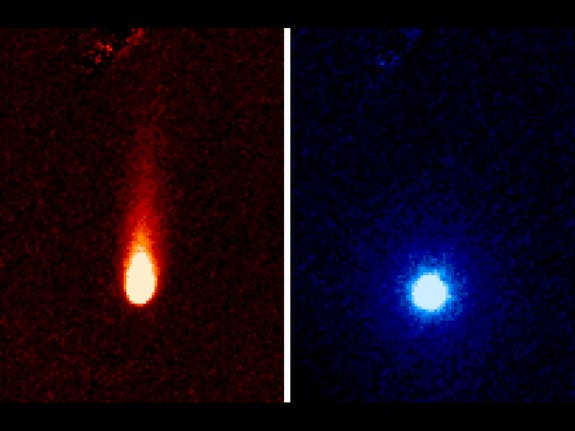
Hailed by many as the “comet of the century”, the ISON comet is expected to blaze so bright after it enters the inner solar system that it will become visible even to the naked eye from here on Earth and for many months too. This only if it will survive the first leg of its journey and doesn’t get disintegrated as it slowly but surely gets more and more closer to the sun’s warm touch.
For now, scientists can’t be sure if the comet will make it, and after all it wouldn’t be the first alleged “comet of the century” that ends to shreds before it even gets the chance to make a name for itself. This is because the comet is still far away from the sun and, more importantly, from Earth where the observational instruments pointed towards ISON are located.
Last month, the comet began to enter a critical phase in what astronomers consider to be its maiden voyage through the inner solar system, and NASA took some very interesting photos showing the comet trailing a huge, colored tail of gas and dust. Taken by the infrared Spitzer Space Telescope, these photos reveal that dust and carbon dioxide gas are streaming off Comet ISON, forming a tail about 186,400 miles (300,000 kilometers) long. This translates into emissions of about 2.2 million pounds (1 million kilograms) of what is most likely carbon dioxide gas and about 120 million pounds (54.4 million kg) of dust every day – rather massive!
“Previous observations made by NASA’s Hubble Space Telescope and the Swift Gamma-Ray Burst Mission and Deep Impact spacecraft gave us only upper limits for any gas emission from ISON,” Carey Lisse, leader of NASA’s Comet ISON Observation Campaign and a senior research scientist at the Johns Hopkins University Applied Physics Laboratory in Laurel, Md., said in a statement. “Thanks to Spitzer, we now know for sure the comet’s distant activity has been powered by gas.”
As the comet will get closer to the sun, scientists will be able to tell more about its composition and density. As it heats up, the comet will burn brighter, but what also means is that more chemicals will begin to evaporate. At the time of the Spitzer observations the comet was 312 million miles (502 million km) from the sun — 3.35 times farther than the Earth-sun distance.
“Much of the carbon in the comet appears to be locked up in carbon dioxide ice,” Lisse said. “We will know even more in late July and August, when the comet begins to warm up near the water-ice line outside of the orbit of Mars, and we can detect the most abundant frozen gas, which is water, as it boils away from the comet.”
On on Nov. 28, however, the comet is expected to skim past the sun’s surface just 724,000 miles (1.16 million km) above it. ISON could blaze up dramatically around this time, perhaps shining as brightly as the full moon in the sky, researchers say. This, of course, if the comet doesn’t disintegrate in the meantime.
This is believed to ISON’s first trip to the inner solar system, and astronomers claim the comet originates from the distant and frigid Oort Cloud, a huge repository of comets that lies between roughly 600 billion and 6 trillion miles (965 billion and 9.65 trillion km) from the sun. The comet, named after the International Scientific Optical Network (ISON) near Kislovodsk, Russia which two Russian astronomers used to discover it, might also offer tangible scientific value, aside from the marvelous fireshow it might display in the coming months.
Comets are primordial bodies composed of water, ammonia, methane, carbon dioxide and other materials — the same fundamental building blocks that gave rise to the planets 4.5 billion years ago. So, in a sense, once researchers have the comet’s elemental composition locked, they can better their understanding of how and when the solar system first formed.
Was this helpful?



